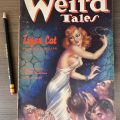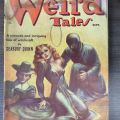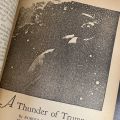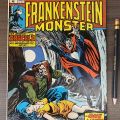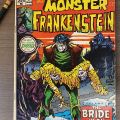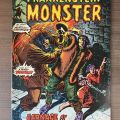During the Spring 2023 semester, Special Collections & Archives collaborated with Dr. Colleen Tripp's English 630, "Modern Monsters: Then & Now." Students in the class selected items from our collections of pulps, comics, and horror stories, then authored a series of blog posts in which they examined visual and other representations of the monstrous in the texts they chose. This is the fifth post of eight in the series.
The Persistent Gender Gap in Pulp and Comic Magazines - An Analysis of Female Representation in Weird Tales in the 1930s and Marvel’s Frankenstein Monster Comics in the 1970s
The representation of women in pulp literature and comics has been a subject of ongoing scrutiny and criticism in popular culture. Pulp magazines and comics have the power to shape our perception of society and the people in it. They are not mere works of imagination but reflect the society that produced them. With that in mind, this blog post aims to compare the female representation on the cover of Weird Tales in the 1930s and Marvel's The Monster of Frankenstein comics in the 1970s and how, unfortunately, it has not significantly changed over time.
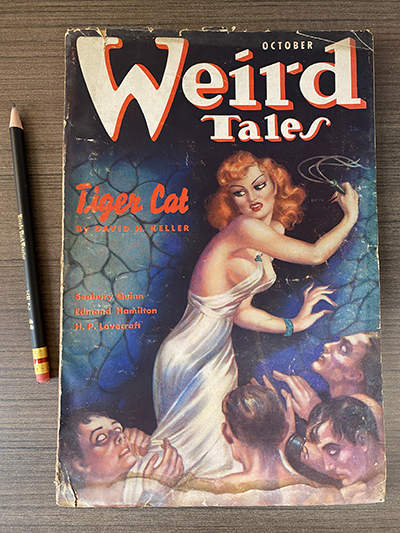 Pulp magazines, including Weird Tales, were a significant cultural phenomenon in the United States in the early to mid-20th century. They were cheaply produced, highly popular magazines that published a wide range of genre fiction, including science fiction, fantasy, horror, adventure, and crime. The term "pulp" refers to the low-quality, highly acidic paper on which these magazines were printed1.
Pulp magazines, including Weird Tales, were a significant cultural phenomenon in the United States in the early to mid-20th century. They were cheaply produced, highly popular magazines that published a wide range of genre fiction, including science fiction, fantasy, horror, adventure, and crime. The term "pulp" refers to the low-quality, highly acidic paper on which these magazines were printed1.
Weird Tales was one of the most famous and influential pulp magazines. It was first published in 1923 and ran until 1954, with a brief revival in the 1970s. The magazine specialized in publishing horror and weird fiction, and its pages featured the work of many now-famous writers, including H.P. Lovecraft, Robert E. Howard, and Clark Ashton Smith2. Pulp magazines such as Weird Tales often portray women as either femmes fatales, damsels in distress, or objects of desire or torture, on covers3. The women were often scantily clad and portrayed in distress or fear. Most often, women were not central to the plot but were used as a prop to attract male readers.
The cover art for the October 1937 issue of Weird Tales magazine was created by the artist Margaret Brundage, who was known for her provocative and often controversial artwork4. It is possible that the woman depicted on the cover is a character from one of the stories featured in the magazine, or she may be a generic image meant to appeal to the publication's target audience of horror, fantasy, and science fiction fans. The woman is likely a dominatrix or femme fatale character. She is wearing a white, low-cut negligee and holding a whip, suggesting a theme of BDSM or eroticism. The fact that she is looking down at a group of men at her feet may indicate that she is in a position of power or control over them. It is worth noting that this type of imagery and content was not uncommon for pulp magazines of this era, which often featured provocative or sensational cover art in order to attract readers. The female characters in the stories themselves were often two-dimensional, and only there just to further the male protagonist's character development. This type of representation of women was a clear indication of the gender gap in these types of publications.
 Marvel's The Frankenstein Monster comic was first published in 1973, during a time of significant cultural change in the United States. The 1960s and early 1970s were a period of political and social upheaval, marked by the civil rights movement, the anti-war movement, and the counterculture. Against this backdrop, Marvel's The Frankenstein Monster comic reflected a growing interest in horror and gothic themes in popular culture. The comic was part of Marvel's line of horror comics, which also included titles such as Tomb of Dracula and Werewolf by Night.
Marvel's The Frankenstein Monster comic was first published in 1973, during a time of significant cultural change in the United States. The 1960s and early 1970s were a period of political and social upheaval, marked by the civil rights movement, the anti-war movement, and the counterculture. Against this backdrop, Marvel's The Frankenstein Monster comic reflected a growing interest in horror and gothic themes in popular culture. The comic was part of Marvel's line of horror comics, which also included titles such as Tomb of Dracula and Werewolf by Night.
One important cultural context for the comics was the ongoing fascination with Mary Shelley's original novel, Frankenstein, which had been published in 1818. The novel had been adapted for film and television many times, and its themes of science, creation, and humanity's relationship with technology had remained relevant to audiences.
Marvel’s The Frankenstein Monster comics were not any better regarding their representation of women on covers. The first issue appeared in 1973 created by Gary Friedrich (writer) and Mike Ploog (artist)5 and only ran until 1975 with a total of eighteen total issues. Though the frequency of women on the cover increased, the portrayal of female characters was equally problematic. Female characters were often hyper-sexualized and sometimes displayed as victimized, raped, or tortured. Though the female characters sometimes played a central role, their character development was often left underdeveloped or omitted entirely, and their stories revolved around male characters.
The depiction of disempowering and objectified female characters has infiltrated the publishing industry and has been perpetuated over time. The scarcity of positive female character representation and their underdeveloped narratives have reflected not only gender inequality but also a lack of diversity in race, sexual orientation, and abilities, during these publication periods. The gender representation in pulp literature like Weird Tales and Marvel’s The Frankenstein Monster remained stagnant. From the 1930s to the 1970s and until today, women are still not given equitable representation in the publishing industry. Despite the advancements in societal values and the noticeable representation of minority groups, the depiction of women has not caught up with the times. Though many strides have been made, there is still much work to be done to reach truly inclusive and diverse representation.
1. “Pulp Fiction Definition & Meaning.” Dictionary.com, https://www.dictionary.com/browse/pulp-fiction#:~:text=Pulp%20fiction%20refers%20to%20a,paper%20it%20was%20printed%20on.
2. Weird Tales, https://www.pulpmags.org/content/info/weird-tales.html.
3. “Research Guides: American Women: Resources from the Serial & Government Publications Collections: Pulp Fiction.” Pulp Fiction - American Women: Resources from the Serial & Government Publications Collections - Research Guides at Library of Congress, https://guides.loc.gov/american-women-serials/popular-culture/pulp-fiction.
4. Jarvis, Alice. “The Colorful World of Pulp Fiction.” The Independent, Independent Digital News and Media, 12 Sept. 2010, https://www.independent.co.uk/arts-entertainment/books/features/the-colourful-world-of-pulp-fiction-2077467.html.
5. Markstein, Donald D. “Monster of Frankenstein.” Don Markstein's Toonopedia: Monster of Frankenstein, http://www.toonopedia.com/franken3.htm.



